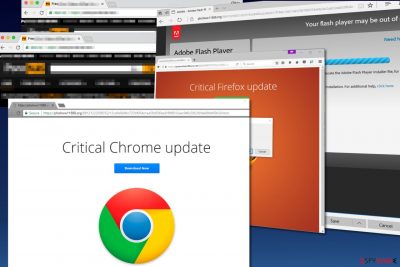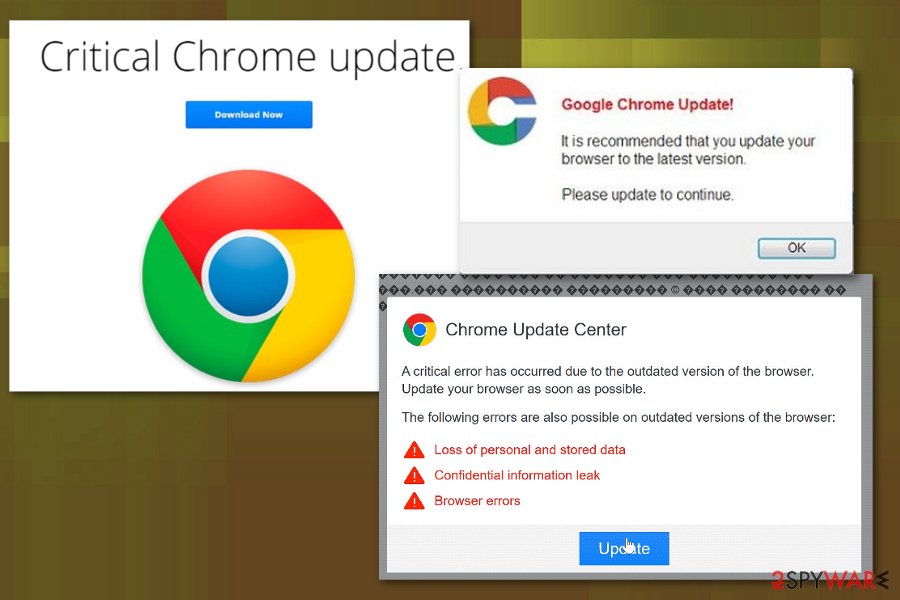Get rid of the Critical Chrome Update scam (2021 guide)
Critical Chrome Update virus Removal Guide
What is Critical Chrome Update virus?
Critical Chrome Update is the fake alert that drops Kovter.C malware on the computer

Critical Chrome Update is the scam that displays fake alerts about the needed browser or system updates and this way tricks people into installing other possibly malicious programs to the computer. If you are constantly redirected and such pop-ups go to your screen repeatedly, you should check your computer for Chrome virus – a potentially unwanted program that can be secretly running on the system.
Note that Critical Chrome Update virus is totally malicious as it can emerge on your screen after clicking on one of Traffic Junky ads.[1] This ad-supported network is known to be serving promotional content on adult-only websites, and therefore visitors of these domains fell victims to KovCoreG malvertising attack[2] that pushes Kovter virus to victims’ computer. Installation of severe malware as such can also be a result of constant alerts about alleged updates.
| Name | Critical Chrome Update scam |
|---|---|
| Category | Malware |
| Family | Chrome virus |
| Symptoms | Delivers fake alerts, warning messages claiming about needed software, updates or additional programs. Tricks into installing fake applications, rogue tools |
| Main danger | Infects the system with malware, in particular, trojans and ransom-demanding threats |
| Distribution | Software bundles, PUPs installed on the system already, deceptive ads, software cracks |
| Elimination | For removal, use a reliable anti-malware program |
Critical Chrome Update scam is a social engineering attack or a campaign based on technical support scam tactics. Unfortunately, such messages and various alerts can lead to the installation of rogue tools, applications, useless programs.
However, scams like this, in most cases, deliver messages and redirect to questionable or even malicious domains as hosts:
- iexaidlepro.org
- johphblogger-hints-and-tips.org
- tahxiintimes-niedersachsen.org
These pop-ups can also provide messages with phone numbers that claim to connect victims with the technical support team. Nevertheless, they are fake, and official technical support services are not delivering messages like this, especially are not encouraging to call questionable numbers. As a result, remove Critical Chrome Update virus without interacting and calling the provided number or contacting people behind the threat in any other way.
To go back to your previous browsing, get an automatic anti-malware tool and clean the machine fully. The proper scam removal requires tools like SpyHunter 5Combo Cleaner, Malwarebytes so that the system gets fully recovered.

A detailed scheme of the Critical Chrome Update scam functionality
After managing to compromise the Traffic Junky ad network, which serves ads via popular adult-oriented sites such as Pornhub, cybercriminals are now capable of serving deceptive via common web pages. As a result, unsuspecting users can easily get infected with click-fraud malware known as Kovter Trojan.
Users who click on such ads are exposed to a malvertising attack that redirects them to deceptive pages that are picked based on their web browser used. Following the browser type and version, victims receive bogus offers to install one of these updates:
- Critical Chrome Update
- Critical Firefox Update
- Adobe Flash Player update (Microsoft Edge/Internet Explorer users).
The final alert is picked using a JavaScript code that is the same as the one used in Neutrino and NeutrAds.
Research reveals that the attack chain starts with a redirect from advertisingms[.]com domain which corrupts the final link and throws the victim to a compromised malware-serving site. According to Proofpoint, this domain “inserts a call hosted behind KeyCDN,” which happens to be a giant content delivery network.
Critical Chrome Update scam suggests installing an update for the popular web browser, however, instead of updating the browser, it drops a ZIP archive that contains a runme.js file. Once executed, it addresses the server responsible for the social engineering attack.[3] The .JS file the downloads two files to victim’s computer – .flv and .mp4 format file.
FLV file consists of three random digits, and the rest of them belong to an RC4 key. The MP4 record is encrypted with this key and hex-encoded. The MP4 file also stores a Powershell script that contains shellcode used to download and execute AVI file (Kovter virus).

Particular functions of the virus
Once executed, Kovter virus establishes itself into Windows Registry rather than dropping some files on the system. This way, malicious software attempts to avoid detection. Besides, the virus sets up specific autorun entries, which runs the malware as soon as the victim starts the computer.
The malware operates silently, and the only noticeable problem is a slight decrease in the computer’s performance. However, the majority of users might not suspect anything if they do not have anti-malware programs installed on their PCs.
It is possible to notice and avoid possible infections
Dieviren.de team says[4] that the trick to avoid installing the malicious Critical Chrome Update or Urgent Chrome Update, as well as malware delivered via deceptive versions of Flash Player or other well-known programs is to never install updates from random Internet sites.
Although cybercriminals use various techniques to trick victims into clicking on malicious advertisements, the method that is based on fake “updates” is actually very common and can be recognized easily. Such a technique mainly gets used to deliver more severe malware and directly infect the machine with threats.
When deceptive advertisement looks legit and includes official logos of the promoted software, it seems to be trustful and people tend to click on such content. However, you should never rely on the pop-up that claims you need to install or update anything randomly. The official software creators and providers are not showing such messages on browsers.
If you suspect that you need an update for Chrome – simply visit the official browser’s developers’ site and check whether there is an update available. However, when installing an application or direct program/ software update be aware of the additional installations. Choose Advanced or Custom options to avoid any unwanted applications.
Remove Kovter.C virus and stop the scammy messages
If you were redirected to a site containing Critical Chrome Update virus, close the web page immediately. If it downloaded the malicious ZIP file to your computer automatically, do not open it and delete it as soon as possible.
However, if you launched the deceptive record, run anti-malware software as soon as you can (ideally, do it after performing a clean system boot).
To finish the removal, update your anti-malware software and scan your computer several times. It is essential to delete Kovter Trojan as soon as possible as it can perform a series of illegal activities on your computer.
You should remove virus with updated anti-spyware to be totally sure that all the related files, applications, and even malware get eliminated during one system check.
You may remove virus damage with a help of FortectIntego. SpyHunter 5Combo Cleaner and Malwarebytes are recommended to detect potentially unwanted programs and viruses with all their files and registry entries that are related to them.
Getting rid of Critical Chrome Update virus. Follow these steps
Uninstall from Windows
Instructions for Windows 10/8 machines:
- Enter Control Panel into Windows search box and hit Enter or click on the search result.
- Under Programs, select Uninstall a program.

- From the list, find the entry of the suspicious program.
- Right-click on the application and select Uninstall.
- If User Account Control shows up, click Yes.
- Wait till uninstallation process is complete and click OK.

If you are Windows 7/XP user, proceed with the following instructions:
- Click on Windows Start > Control Panel located on the right pane (if you are Windows XP user, click on Add/Remove Programs).
- In Control Panel, select Programs > Uninstall a program.

- Pick the unwanted application by clicking on it once.
- At the top, click Uninstall/Change.
- In the confirmation prompt, pick Yes.
- Click OK once the removal process is finished.
Remove from Google Chrome
Delete malicious extensions from Google Chrome:
- Open Google Chrome, click on the Menu (three vertical dots at the top-right corner) and select More tools > Extensions.
- In the newly opened window, you will see all the installed extensions. Uninstall all the suspicious plugins that might be related to the unwanted program by clicking Remove.

Clear cache and web data from Chrome:
- Click on Menu and pick Settings.
- Under Privacy and security, select Clear browsing data.
- Select Browsing history, Cookies and other site data, as well as Cached images and files.
- Click Clear data.

Change your homepage:
- Click menu and choose Settings.
- Look for a suspicious site in the On startup section.
- Click on Open a specific or set of pages and click on three dots to find the Remove option.
Reset Google Chrome:
If the previous methods did not help you, reset Google Chrome to eliminate all the unwanted components:
- Click on Menu and select Settings.
- In the Settings, scroll down and click Advanced.
- Scroll down and locate Reset and clean up section.
- Now click Restore settings to their original defaults.
- Confirm with Reset settings.

Remove from Mozilla Firefox (FF)
Remove dangerous extensions:
- Open Mozilla Firefox browser and click on the Menu (three horizontal lines at the top-right of the window).
- Select Add-ons.
- In here, select unwanted plugin and click Remove.

Reset the homepage:
- Click three horizontal lines at the top right corner to open the menu.
- Choose Options.
- Under Home options, enter your preferred site that will open every time you newly open the Mozilla Firefox.
Clear cookies and site data:
- Click Menu and pick Settings.
- Go to Privacy & Security section.
- Scroll down to locate Cookies and Site Data.
- Click on Clear Data…
- Select Cookies and Site Data, as well as Cached Web Content and press Clear.

Reset Mozilla Firefox
If clearing the browser as explained above did not help, reset Mozilla Firefox:
- Open Mozilla Firefox browser and click the Menu.
- Go to Help and then choose Troubleshooting Information.

- Under Give Firefox a tune up section, click on Refresh Firefox…
- Once the pop-up shows up, confirm the action by pressing on Refresh Firefox.

Remove from Microsoft Edge
Delete unwanted extensions from MS Edge:
- Select Menu (three horizontal dots at the top-right of the browser window) and pick Extensions.
- From the list, pick the extension and click on the Gear icon.
- Click on Uninstall at the bottom.

Clear cookies and other browser data:
- Click on the Menu (three horizontal dots at the top-right of the browser window) and select Privacy & security.
- Under Clear browsing data, pick Choose what to clear.
- Select everything (apart from passwords, although you might want to include Media licenses as well, if applicable) and click on Clear.

Restore new tab and homepage settings:
- Click the menu icon and choose Settings.
- Then find On startup section.
- Click Disable if you found any suspicious domain.
Reset MS Edge if the above steps did not work:
- Press on Ctrl + Shift + Esc to open Task Manager.
- Click on More details arrow at the bottom of the window.
- Select Details tab.
- Now scroll down and locate every entry with Microsoft Edge name in it. Right-click on each of them and select End Task to stop MS Edge from running.

If this solution failed to help you, you need to use an advanced Edge reset method. Note that you need to backup your data before proceeding.
- Find the following folder on your computer: C:\\Users\\%username%\\AppData\\Local\\Packages\\Microsoft.MicrosoftEdge_8wekyb3d8bbwe.
- Press Ctrl + A on your keyboard to select all folders.
- Right-click on them and pick Delete

- Now right-click on the Start button and pick Windows PowerShell (Admin).
- When the new window opens, copy and paste the following command, and then press Enter:
Get-AppXPackage -AllUsers -Name Microsoft.MicrosoftEdge | Foreach {Add-AppxPackage -DisableDevelopmentMode -Register “$($_.InstallLocation)\\AppXManifest.xml” -Verbose

Instructions for Chromium-based Edge
Delete extensions from MS Edge (Chromium):
- Open Edge and click select Settings > Extensions.
- Delete unwanted extensions by clicking Remove.

Clear cache and site data:
- Click on Menu and go to Settings.
- Select Privacy, search and services.
- Under Clear browsing data, pick Choose what to clear.
- Under Time range, pick All time.
- Select Clear now.

Reset Chromium-based MS Edge:
- Click on Menu and select Settings.
- On the left side, pick Reset settings.
- Select Restore settings to their default values.
- Confirm with Reset.

Delete from Safari
Remove unwanted extensions from Safari:
- Click Safari > Preferences…
- In the new window, pick Extensions.
- Select the unwanted extension and select Uninstall.

Clear cookies and other website data from Safari:
- Click Safari > Clear History…
- From the drop-down menu under Clear, pick all history.
- Confirm with Clear History.

Reset Safari if the above-mentioned steps did not help you:
- Click Safari > Preferences…
- Go to Advanced tab.
- Tick the Show Develop menu in menu bar.
- From the menu bar, click Develop, and then select Empty Caches.

After uninstalling this potentially unwanted program (PUP) and fixing each of your web browsers, we recommend you to scan your PC system with a reputable anti-spyware. This will help you to get rid of Critical Chrome Update registry traces and will also identify related parasites or possible malware infections on your computer. For that you can use our top-rated malware remover: FortectIntego, SpyHunter 5Combo Cleaner or Malwarebytes.
How to prevent from getting malware
Do not let government spy on you
The government has many issues in regards to tracking users' data and spying on citizens, so you should take this into consideration and learn more about shady information gathering practices. Avoid any unwanted government tracking or spying by going totally anonymous on the internet.
You can choose a different location when you go online and access any material you want without particular content restrictions. You can easily enjoy internet connection without any risks of being hacked by using Private Internet Access VPN.
Control the information that can be accessed by government any other unwanted party and surf online without being spied on. Even if you are not involved in illegal activities or trust your selection of services, platforms, be suspicious for your own security and take precautionary measures by using the VPN service.
Backup files for the later use, in case of the malware attack
Computer users can suffer from data losses due to cyber infections or their own faulty doings. Ransomware can encrypt and hold files hostage, while unforeseen power cuts might cause a loss of important documents. If you have proper up-to-date backups, you can easily recover after such an incident and get back to work. It is also equally important to update backups on a regular basis so that the newest information remains intact – you can set this process to be performed automatically.
When you have the previous version of every important document or project you can avoid frustration and breakdowns. It comes in handy when malware strikes out of nowhere. Use Data Recovery Pro for the data restoration process.
- ^ Kovter Group malvertising campaign exposes millions to potential ad fraud malware infections. Proofpoint. Threat Insight Blog.
- ^ Tom Spring. Porn Site Becomes Hub for Malvertising Campaigns. Threatpost. The First Stop for Security News.
- ^ George V. Hulme and Joan Goodchild. What is social engineering? How criminals exploit human behavior. CSOonline. Technology news and analysis.
- ^ DieViren. DieViren. Malware Removal Guides.





















